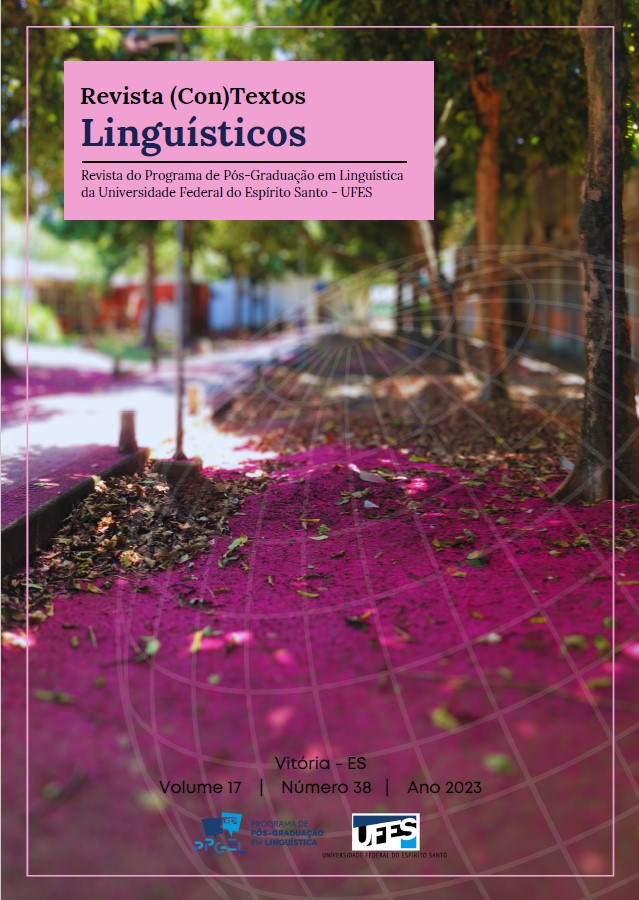Biblical typology and the semiotization in the theological discourse
DOI:
https://doi.org/10.47456/cl.v17i38.42269Keywords:
biblical typology, type, theological discourse, semiotization.Abstract
This paper focuses on the phenomenon of biblical typology in a discursive perspective, taking into account how the are presented in its linguistic aspect in the Scripture and, thus, considering as evidences the links between its two major discursive blocks, the Old and the New Testament. The path to be followed comprises theoretical exposition, from which the theological definition for the typology and the concepts and categories of the Semiolinguistic theory are retrieved, and then proceed to a sample analysis that demonstrates the linguistic-discursive process of meaning of a type depending on the circunstances of production. The analysis supports the hypothesis of a prospective semiotization of the world, operated by the inscription of the type of Christ in the biblical Old Testament and its correspondent revealed in the New Testament context. The phenomenon in question is also confirmed as discursive evidence that advocates for close relationship of correspondence between the two large sets of texts that constitute the biblical theological discourse.
Downloads
References
BÍBLIA SAGRADA. Português. Bíblia Sagrada. Versão Almeida Revista e Corrigida - SBB. São Paulo: Vida Nova, 1998.
CHARAUDEAU, P. Grammaire du sens et de l’expression. Paris: Hachette, 1992.
CHARAUDEAU, P. Uma análise semiolinguística do texto e do discurso. In: PAULIUKONIS, M. A. L.; GAVAZZI, S. (orgs.). Da língua ao discurso: reflexões para o ensino. Rio de Janeiro: Lucerna, 2005, p. 11-29.
CHARAUDEAU, P. Linguagem e discurso: modos de organização. São Paulo: Contexto, 2008.
DAVIDSON, R. M. A natureza e identidade da tipologia bíblica: questões cruciais. Tradução de Ozeas Caldas Moura. In: revista Hermenêutica, 2004, p. 61-99.
LUND, E. Hermenêutica: regras de interpretação das sagradas escrituras. Tradução de Etuvino Adiers. Editora Vida, 1999.
MAINGUENEAU, D. L’analyse des discours constituants. In: MARI, Hugo et al. (org.). Fundamentos e dimensões da análise do discurso. Belo Horizonte: Carol Borges, 1999.
MAINGUENEAU, D. A noção de hipernunciador. In: revista Polifonia, EDUFMT, Cuiabá, n.10, 2005, p. 75-97.
MAINGUENEAU, D. La difficile émergence d’une analyse du discours religieux. In: Langage et société, 4, n. 130, 2009.
MAINGUENEAU, D. Clareza do texto, discursos constituintes e quadro hermenêutico. In: Revista do Programa de Pós-Graduação em Letras da Universidade de Passo Fundo - v. 8 - n. 1 - p. 11-19 - jan./jun. 2012.
NASCIMENTO, J. V. O discurso teológico como discurso constituinte. In: NASCIMENTO, J.V.; FERREIRA, A. Discursos constituintes. São Paulo: Blucher, 2020b, p. 34-59.
RICOEUR, P. A hermenêutica bíblica. São Paulo: Edições Loyola, 2007.
SCHLEIERMACHER, F. de. Hermenêutica: arte e técnica da interpretação. Petrópolis: ed. Vozes, 2015.
SMITH, J. K. A. A queda da interpretação: fundamentos filosóficos para uma hermenêutica criacional. Tradução de Valéria Lamim. 1.ed. Rio de Janeiro: Thomas Nelson Brasil, 2021.
Downloads
Published
Issue
Section
License
Copyright (c) 2023 Revista (Con)Textos Linguísticos

This work is licensed under a Creative Commons Attribution-NonCommercial 4.0 International License.
Authors assign the copyright of the article to the publisher of Revista (Con)Textos Linguísticos (Graduate Program in Linguistics, Ufes), if the submission is accepted for publication. Responsibility for the content of articles rests exclusively with their authors. The full or partial submission of the text already published in this periodical to any other periodical is prohibited.
This work is licensed under a Creative Commons Attribution-NonCommercial 4.0 International License.



